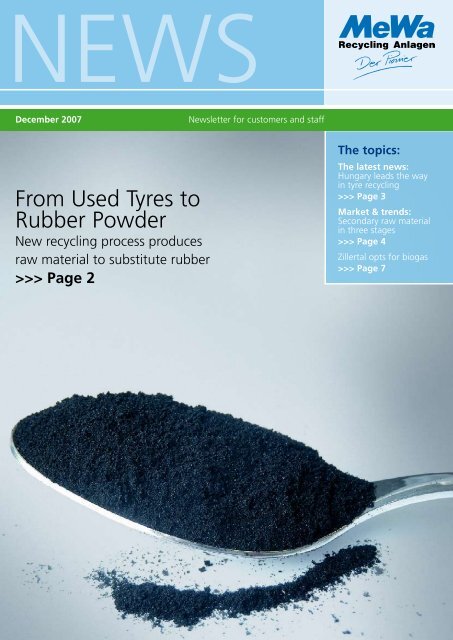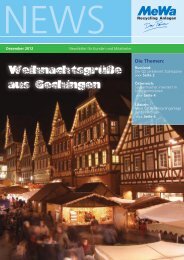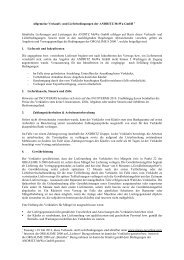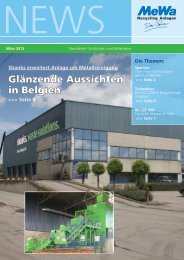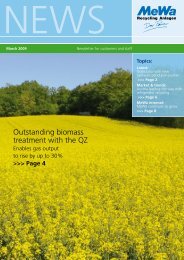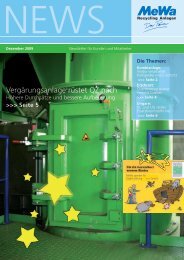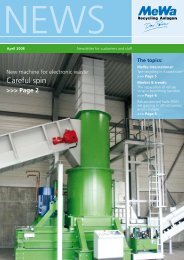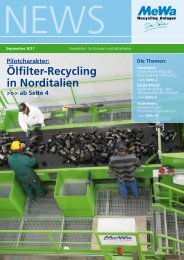R From used tyres to rubber powder - MeWa Recycling Maschinen ...
R From used tyres to rubber powder - MeWa Recycling Maschinen ...
R From used tyres to rubber powder - MeWa Recycling Maschinen ...
Create successful ePaper yourself
Turn your PDF publications into a flip-book with our unique Google optimized e-Paper software.
NEWS<br />
December 2007<br />
<strong>From</strong> Used Tyres <strong>to</strong><br />
Rubber Powder<br />
New recycling process produces<br />
raw material <strong>to</strong> substitute <strong>rubber</strong><br />
>>> Page 2<br />
Newsletter for cus<strong>to</strong>mers and staff<br />
The <strong>to</strong>pics:<br />
The latest news:<br />
Hungary leads the way<br />
in tyre recycling<br />
>>> Page 3<br />
Market & trends:<br />
Secondary raw material<br />
in three stages<br />
>>> Page 4<br />
Zillertal opts for biogas<br />
>>> Page 7
Latest news<br />
<strong>From</strong> <strong>used</strong> <strong>tyres</strong> <strong>to</strong> <strong>rubber</strong> <strong>powder</strong><br />
New process provides high-quality secondary raw material as a natural <strong>rubber</strong><br />
substitute<br />
Monoculture: Rubber plantation in Asia.<br />
Rubber products require <strong>rubber</strong> as<br />
a raw material. Either natural <strong>rubber</strong>,<br />
which is often cultivated on<br />
large plantations – with all the problems<br />
associated with a monoculture. Or alternatively<br />
synthetic <strong>rubber</strong>, which is produced<br />
using crude oil. Both processes use<br />
a high amount of resources. At the end<br />
of the chain, mountains of <strong>used</strong> car <strong>tyres</strong><br />
crop up on the landscape.<br />
These waste sites are taken on by <strong>used</strong><br />
tyre and <strong>rubber</strong> recycling plants nowadays.<br />
Certain types of plant produce a very fine<br />
<strong>rubber</strong> granulate here.<br />
This granulate can later be <strong>used</strong> for the<br />
manufacture of new products. Combined<br />
with adhesives, for example, it can be <strong>used</strong><br />
in the construction of sports complexes,<br />
in moulded parts for road construction,<br />
as an additive <strong>to</strong> asphalt or in the construction<br />
industry. Due <strong>to</strong> its material properties,<br />
however, the granules are limited<br />
<strong>to</strong> certain applications.<br />
Active Fine Grinding<br />
<strong>MeWa</strong>, the Gechingen-based machinery<br />
builder, has developed its own process<br />
<strong>to</strong> make this granulate in<strong>to</strong> a high-quality<br />
secondary raw material. The process works<br />
at ambient temperature without the need<br />
<strong>to</strong> add nitrogen. The so-called active fine<br />
grinding of old <strong>rubber</strong> produces a raw<br />
material with the best properties.<br />
Active means the processing or pressing<br />
of the <strong>rubber</strong> <strong>powder</strong> produced in<strong>to</strong><br />
moulded parts without adding adhesives.<br />
In future the material can be directly<br />
added <strong>to</strong> the natural <strong>rubber</strong> in many<br />
applications, replacing between 10 and<br />
90 percent of it depending on the standard.<br />
This makes the <strong>powder</strong> suitable for<br />
a variety of products, as about the same<br />
amount of <strong>rubber</strong> that tyre manufacturers<br />
need is required for other applications in<br />
the market.<br />
The <strong>rubber</strong> <strong>powder</strong> end product stands<br />
out due <strong>to</strong> its fine grain size and therefore<br />
looks no different <strong>to</strong> the original <strong>rubber</strong>.<br />
As the <strong>powder</strong> can be further processed<br />
without expensive adhesives, it is itself<br />
recyclable. The hither<strong>to</strong> disadvantages<br />
of the granules produced are therefore<br />
eliminated. The <strong>rubber</strong> from the recycling<br />
process is not only considerably cheaper<br />
<strong>to</strong> make than natural <strong>rubber</strong>, it also conserves<br />
valuable resources. ■<br />
Using the active fine<br />
grinding process, <strong>MeWa</strong><br />
produces a substitute raw<br />
material of high purity out<br />
of <strong>used</strong> <strong>tyres</strong>.<br />
The <strong>powder</strong> can be mixed<br />
back in for the manufacture<br />
of <strong>rubber</strong> products<br />
without any problem.<br />
Up <strong>to</strong> 90 per cent of the<br />
natural <strong>rubber</strong> originally<br />
<strong>used</strong> can be replaced in<br />
this way.<br />
Rubber granules.<br />
Active <strong>rubber</strong> <strong>powder</strong>.<br />
<strong>MeWa</strong>-News December 2007
Hungary leads the way in tyre recycling<br />
Output offers wide sales opportunities with high earnings<br />
In the Hungarian <strong>to</strong>wn of<br />
Cegléd, <strong>MeWa</strong> is currently<br />
building an ultramodern plant<br />
for recycling old <strong>tyres</strong>. It produces<br />
a special end product in<br />
the form of an uncontaminated<br />
<strong>rubber</strong> <strong>powder</strong> for the highest<br />
demands.<br />
Already children benefit from<br />
recycling products.<br />
Fall protection: Moulded products<br />
made of <strong>rubber</strong> granules.<br />
<strong>MeWa</strong>-News December 2007<br />
The active tyre <strong>powder</strong> from the <strong>used</strong><br />
tyre processing plant in the Hungarian<br />
<strong>to</strong>wn of Cegléd can be mixed<br />
directly back in<strong>to</strong> the <strong>rubber</strong> production<br />
process as a genuine secondary raw material.<br />
Depending on the product, 10 <strong>to</strong><br />
90 per cent of the natural <strong>rubber</strong> originally<br />
<strong>used</strong> can be replaced with this material.<br />
The material is traded as correspondingly<br />
valuable commodity. The market price is<br />
<strong>From</strong> June 2008 the plant in Cegléd will process<br />
20.000 <strong>to</strong>nnes of <strong>used</strong> <strong>tyres</strong> per annum.<br />
around three times higher than is usual for<br />
the conventionally produced granules.<br />
The plant in the Hungarian Puszta<br />
around 100 kilometres south-east of<br />
Budapest will be operated by Euro-Rubber<br />
GmbH. Company owner, Karoly Sziraki,<br />
has been in the tyre processing industry<br />
for over 15 years and processes around<br />
half of the 40,000 <strong>to</strong>nnes of old <strong>tyres</strong><br />
collected every year in Hungary, mainly for<br />
thermal recycling in the cement industry.<br />
The plan is <strong>to</strong> widen this sales outlet in<br />
future. To reach this goal, the entrepreneur<br />
has made a large investment. The best<br />
currently available tyre recycling technology<br />
will soon enable a wide range of <strong>rubber</strong><br />
recycling products.<br />
The new plant shreds both truck and<br />
car <strong>used</strong> <strong>tyres</strong> according <strong>to</strong> the <strong>MeWa</strong><br />
three-stage principle: shredding, granulating<br />
line, fine grinding. The <strong>rubber</strong><br />
granules in sizes of 0 <strong>to</strong> 4 mm are ex-<br />
Latest news<br />
pected <strong>to</strong> be sold for a variety of applications.<br />
For example, its Hungarian sister<br />
company, Euro-Novex GmbH, makes the<br />
granules in<strong>to</strong> sound insulation mats for the<br />
building industry. An order is in the pipeline<br />
from the Hungarian ministry of transport.<br />
The plan is <strong>to</strong> use the <strong>rubber</strong> <strong>powder</strong><br />
mixture <strong>to</strong> comfortably expand the cycle<br />
paths in the predominantly flat country<br />
in<strong>to</strong> a 9000-kilometre-long network.<br />
And the small grains of <strong>rubber</strong> can also be<br />
incorporated in<strong>to</strong> playground surfaces,<br />
providing the children with an effective<br />
form of protection when they fall.<br />
However, the new plant further processes<br />
a large part of the granular material<br />
in<strong>to</strong> a much more valuable <strong>rubber</strong> <strong>powder</strong>.<br />
The newly developed fine <strong>rubber</strong> mill<br />
ultimately makes old <strong>tyres</strong> in<strong>to</strong> a secondary<br />
raw material in its most refined form. The<br />
active <strong>rubber</strong> <strong>powder</strong> can be directly mixed<br />
with natural <strong>rubber</strong> at the right pressure<br />
and temperature conditions. Rubber<br />
hoses, <strong>rubber</strong> mats or other technical <strong>rubber</strong><br />
products can therefore be produced in<br />
future out of 10 <strong>to</strong> 90 per cent recycled<br />
material depending on the product. ■<br />
Cegléd – gateway <strong>to</strong> the Puszta<br />
The city with its 38,000 inhabitants<br />
is well-known as a spa. Nearby rises 17<br />
mineral sources, which are bottled as<br />
the popular Mira-water.<br />
Cegléd is also the gateway <strong>to</strong> the<br />
great Hungarian lowlands. The landscape<br />
known as Puszta with its sandy<br />
ground, draw wells and isolated<br />
farms <strong>to</strong>ok up half the national terri<strong>to</strong>ry<br />
of Hungary. Tourists like this wide and<br />
flat piece of cultivated landscape as a<br />
paradise for horseback riding.
Market & trends<br />
Secondary raw material in three stages<br />
Tyre <strong>Recycling</strong> with<br />
the latest technology<br />
Recycle before incinerating.<br />
This guideline also applies <strong>to</strong><br />
old car and truck <strong>tyres</strong>. The<br />
maxim is <strong>to</strong> separate the <strong>rubber</strong>,<br />
steel and textile parts<br />
from old <strong>tyres</strong><br />
and <strong>to</strong> put<br />
them back<br />
in<strong>to</strong> the raw<br />
material<br />
cycle. <strong>MeWa</strong><br />
<strong>Recycling</strong> supplies<br />
complete<br />
recycling plants<br />
for this purpose<br />
from one source.<br />
Granulating line.<br />
Tyre shreds after pre-shredding.<br />
Anyone investing in a tyre recycling<br />
plant expects it <strong>to</strong> be a costeffective<br />
operation. Besides a<br />
fixed amount paid <strong>to</strong> the opera<strong>to</strong>r for the<br />
disposal of the old <strong>tyres</strong>, further income<br />
also has <strong>to</strong> be made from the neatly sorted<br />
scrap. The sales income naturally depends<br />
on the quality of the output material and<br />
the pricing structure depends on processing<br />
that is as efficient as possible.<br />
For this purpose, <strong>MeWa</strong> has designed<br />
a three-stage processing principle (shredding,<br />
granulating line, fine grinding),<br />
which ultimately produces very high-<br />
quality materials for recycling. That could<br />
be shreds for thermal recycling, predominantly<br />
in the cement industry, a <strong>rubber</strong><br />
granules between 0 and 4 millimetres<br />
for various applications and, as a premium<br />
product, a genuine secondary raw material<br />
in the form of an active <strong>rubber</strong> <strong>powder</strong>.<br />
This can be directly added back <strong>to</strong><br />
the raw material <strong>used</strong> in the production<br />
of <strong>rubber</strong>.<br />
The machines for the three-stage<br />
process have also been designed by the<br />
company from Gechingen. Pre-shredding<br />
is done by a UNI-CUT ® UC rotary shear.<br />
This shreds complete car and truck <strong>tyres</strong><br />
up <strong>to</strong> a diameter of 1.4 metres. What is<br />
special about this is that the textile and<br />
steel beading can be left in the tyre <strong>to</strong> start<br />
with and does not require a great deal of<br />
expense and effort <strong>to</strong> be sorted out by<br />
<strong>MeWa</strong>-News December 2007
hand. This step is done mechanically in<br />
the course of the process. The final result<br />
is even, approximately hand-sized pieces<br />
of tyre (shreds).<br />
High Purity of Granules<br />
A granulating line then turns these<br />
shreds in<strong>to</strong> very pure granules using the<br />
UNI-CUT ® UG granula<strong>to</strong>rs and UNI-CUT ®<br />
USM cutting mills. The tyre pieces are granulated<br />
in several stages <strong>to</strong> a grain size<br />
between 0 and 4 mm and filled in big<br />
bags ready for sale in three grain sizes<br />
(0 <strong>to</strong> 0.7 mm, 0.7 <strong>to</strong> 2 mm and 2 <strong>to</strong> 4<br />
mm). After every stage the steel is separa-<br />
Cutting mills granule the <strong>rubber</strong> <strong>to</strong> a grit size<br />
of less than 4 mm.<br />
The granules is packaged in different<br />
grit sizes – ready for sale.<br />
<strong>MeWa</strong>-News December 2007<br />
ted using magnets, whilst textile remains<br />
(fluffs) are extracted by suction. After the<br />
last processing stage comes an elaborate<br />
dividing and cleaning process, which<br />
guarantees the highest quality standards<br />
in the end product. The granule purity levels<br />
at the end are around 99.99 per cent<br />
free of steel wire and 99.9 per cent free<br />
of textile fluff.<br />
For refining purposes, a fine <strong>rubber</strong><br />
grinding mill can turn the cleaned granules<br />
from a size of 2 <strong>to</strong> 4 mm in<strong>to</strong> an<br />
active <strong>rubber</strong> <strong>powder</strong> (< 1 mm) in a third<br />
processing stage. Active <strong>rubber</strong> <strong>powder</strong><br />
means that this material can be mixed<br />
directly with natural <strong>rubber</strong> as a secondary<br />
raw material. Depending on the product<br />
and quality level, between 10 and 90 per<br />
cent of this can be replaced.<br />
This finely ground material can currently<br />
be sold on the market at very high<br />
prices, as the demand for substitute na-<br />
Market & trends<br />
tural <strong>rubber</strong> has grown enormously due<br />
<strong>to</strong> increasing raw material prices. This<br />
tendency is on the increase because<br />
approximately the same amount of natural<br />
<strong>rubber</strong>, which tyre manufacturers need<br />
for new production, is also called for in the<br />
market for other products. ■<br />
Pre-shredding.
Market & trends<br />
Fine grinding<br />
The fine grinding of granules produced from old <strong>tyres</strong> can be done in various ways.<br />
The result is materials with widely differing properties.<br />
Cryogenic process<br />
Also called cold grinding. The <strong>rubber</strong><br />
or the granule is cooled with liquid<br />
nitrogen, making it very brittle. The <strong>rubber</strong><br />
breaks apart like glass during the shredding<br />
process. This makes it possible <strong>to</strong> achieve<br />
very small grain sizes with low mechanical<br />
effort, meaning with little mo<strong>to</strong>r power.<br />
Subsequent application areas include<br />
additives for paints. Due <strong>to</strong> its smooth surface,<br />
however, this finely ground material<br />
cannot be <strong>used</strong> as a natural <strong>rubber</strong> substitute.<br />
High prices for liquid nitrogen also<br />
make it increasingly difficult <strong>to</strong> operate<br />
such plants economically.<br />
Ambient process<br />
Rubber ground at ambient temperature.<br />
The process works like the cryogenic<br />
process with a turbo mill at the shredding<br />
stage, only without the addition of<br />
nitrogen. The grain size is consequently<br />
larger than that achieved with cold grinding.<br />
The process is also cheaper, however.<br />
The consistency of the output material is<br />
also different. The application areas are<br />
therefore very similar <strong>to</strong> the granular material.<br />
The fine grain nevertheless makes the<br />
<strong>powder</strong> from the ambient process considerably<br />
better looking than the coarse<br />
granule, which is reflected in the<br />
attainable market prices.<br />
Active <strong>powder</strong><br />
With the help of special cylindrical<br />
mills, the newly developed process produces<br />
a <strong>rubber</strong> <strong>powder</strong>, which due <strong>to</strong> its<br />
rough and angular surface structure can<br />
itself be re-pressed. As a result, it can also<br />
be directly mixed back in<strong>to</strong> the production<br />
process of technical <strong>rubber</strong> products. Depending<br />
on the quality level required in the<br />
end product, between 10 and 90 per cent<br />
of the natural <strong>rubber</strong> can be replaced. Due<br />
<strong>to</strong> the high raw material prices for natural<br />
<strong>rubber</strong>, the <strong>powder</strong> can also achieve high<br />
market prices. ■<br />
Packaging of <strong>rubber</strong> <strong>powder</strong> – ready for sale.<br />
A <strong>MeWa</strong> fine mill produces <strong>rubber</strong> <strong>powder</strong>.<br />
<strong>MeWa</strong>-News December 2007
Zillertal opts for biogas<br />
In the Austrian valley of<br />
Zillertal, a biogas plant is<br />
currently being established<br />
with preshredding technology<br />
by <strong>MeWa</strong>. The QZ has<br />
convinced the experts in<br />
test runs. Its new field<br />
of application is now eagerly<br />
anticipated.<br />
The plant is expected <strong>to</strong> supply<br />
the Zillertal biogas company, Bioenergie<br />
Schlitters, 330 Kilowatts of<br />
power from January 2008. For this purpose,<br />
Finsterwalder Umwelttechnik GmbH has<br />
designed a concept in which the QZ from<br />
<strong>MeWa</strong> plays a crucial role. Around 6,000<br />
<strong>to</strong>nnes of food waste, biowaste and ou<strong>to</strong>f-date<br />
food are expected <strong>to</strong> be converted<br />
in<strong>to</strong> energy, waste water and compost in<br />
the modern biogas plant in future.<br />
The material from households and <strong>to</strong>urist<br />
establishments in Zillertal must first<br />
be broken down and the contraries in it<br />
separated out. ”In this<br />
respect the QZ has two<br />
immediate advantages<br />
over conventional cutting<br />
systems“, says<br />
Klemens Finsterwalder<br />
from the german planning<br />
agency FITEC. Firstly the machine can<br />
process and separate metallic contraries<br />
without any problem. For example, these are<br />
often found in biowaste in the form of<br />
cutlery from <strong>to</strong>urism businesses. But even<br />
an axle from a biowaste bin or packaged<br />
food are no problem for the QZ.<br />
The particular benefit of the QZ is<br />
shown by its chains when processing the<br />
biomass. These open up the biomass in<br />
such a way that a much larger surface<br />
area is created compared with cut types of<br />
biowaste. This gives the bacteria a much<br />
larger surface area <strong>to</strong> attack during the<br />
fermentation process. The principle is<br />
comparable with that of a mortar, which<br />
really allows the aromas <strong>to</strong> be released<br />
from herbs. Experts are hoping for a usable<br />
energy yield in future, which will beat<br />
similar plants with conventional cutting<br />
systems in the shredding sec<strong>to</strong>r by up <strong>to</strong><br />
30 per cent.<br />
<strong>MeWa</strong>-News December 2007<br />
“In this respect the QZ<br />
has two immediate<br />
advantages over<br />
conventional cutting<br />
systems.“<br />
With its resources and the peasant<br />
culture and tradition the Zillertal is<br />
very popular with ecology-minded<br />
<strong>to</strong>urists.<br />
The contraries are separated at the<br />
Schlitters plant in two stages. After shredding<br />
in the QZ and again later during the<br />
continuous fermenter cleaning process.<br />
The conditioned organic remains are sanitised<br />
in a double-tube heat exchanger after<br />
shredding and added <strong>to</strong> the fermenter.<br />
The process itself requires electrical and<br />
thermal energy. These<br />
are produced from<br />
the biogas in a combined<br />
heat and power<br />
plant. The excess<br />
energy is fed in<strong>to</strong> the<br />
public network in the<br />
form of electricity. The heat is <strong>used</strong> for<br />
heating and hot water production. The<br />
fermentation remains are divided in<strong>to</strong><br />
compost and raw sewage. ■<br />
Schlitters<br />
in the valley of Zillertal<br />
Schlitters is a romantic, family-friendly<br />
village at the entrance <strong>to</strong> the valley of<br />
Zillertal. All those who care for fresh<br />
mountain air and Alpine sports take<br />
<strong>to</strong> the Zillertal and get inspired by the<br />
valley’s scenic beauty and exhilarating<br />
experience, the <strong>to</strong>urism association<br />
promises. The small village with its<br />
1,500 inhabitants offer not only onmountains<br />
adventure for them who<br />
loves <strong>to</strong> take the summit, but also<br />
relief from the stress.<br />
Market & trends<br />
<strong>From</strong> January 2008 the fermenter delivers<br />
nonpolluting energy.<br />
Even packed food can be processed<br />
by the QZ.<br />
The QZ at the biogas plant in Schlitters.
<strong>MeWa</strong>-International<br />
New WEEE plant for Kent<br />
<strong>MeWa</strong> becomes market leader in England<br />
Plastics fraction of high purity.<br />
The electronics recycling company<br />
Specialist WEEE Processing<br />
(SWEEEP Ltd), based in Sittingbourne<br />
Kent opened an Authorized<br />
Treatment Facility <strong>to</strong> deal with the UK’s<br />
electronic waste in June 2007.<br />
“The primary reason for<br />
selecting <strong>MeWa</strong> is that it is the<br />
preferred plant for<br />
WEEE directive compliant<br />
recyclers.”<br />
The plant has a capacity of 80,000<br />
<strong>to</strong>nnes per annum and takes electronic<br />
waste from local authorities, compliance<br />
schemes and businesses all across London<br />
and the South of England.<br />
The completely enclosed QZ dismantles the whole WEEE-scrap.<br />
German company <strong>MeWa</strong> provided<br />
the technology for the plant, this system<br />
includes <strong>MeWa</strong>’s patented QZ machine.<br />
The turn key plant was being installed in<br />
time for the kick off of the WEEE directive<br />
in July. <strong>MeWa</strong> technology was chosen<br />
after extensive visits <strong>to</strong> plants in both the<br />
UK and continental Europe.<br />
Patrick Watts Managing Direc<strong>to</strong>r of<br />
SWEEEP said, “The primary reason for<br />
selecting <strong>MeWa</strong> is that it is the preferred<br />
plant for WEEE directive compliant recyclers<br />
throughout Europe and the UK”.<br />
Trevor Roberts <strong>MeWa</strong>’s UK sales ma-<br />
<strong>MeWa</strong>-News<br />
Impressum<br />
Publisher:<br />
<strong>MeWa</strong> <strong>Recycling</strong> <strong>Maschinen</strong><br />
und Anlagenbau GmbH<br />
Gültlinger Straße 3, 75391 Gechingen<br />
Tel. 0049 (0)7056 925-0<br />
E-Mail: info@mewa-recycling.de<br />
Edi<strong>to</strong>rs: Harald Pandl<br />
nager adds “we are very<br />
pleased <strong>to</strong> deliver this project<br />
<strong>to</strong> the south of England;<br />
this is the seventh<br />
large scale turnkey project<br />
we have installed in<br />
the UK”. ■<br />
Print: Druckhaus Weber GmbH,<br />
Althengstett<br />
Design: <strong>MeWa</strong> in cooperation with<br />
Creativ-Werbung M. Dostal, Tiefenbronn<br />
Pho<strong>to</strong>graph credits: <strong>MeWa</strong>, Euro-Novex<br />
(Page 3), Zillertal-Tourism (Page 7)<br />
Publication frequency: 4 x per year<br />
<strong>MeWa</strong>-News December 2007


